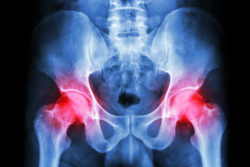Top Class Actions’s website and social media posts use affiliate links. If you make a purchase using such links, we may receive a commission, but it will not result in any additional charges to you. Please review our Affiliate Link Disclosure for more information.

Plaintiff George R. and his wife Patricia R. file the Stryker LFIT V40 lawsuit in Massachusetts federal court, joining an increasing multidistrict litigation filed against Howmedica. The lawsuit was filed on Dec. 29, 2017.
George R. says that he was implanted with an LFIT Anatomic CoCr V40 Femoral Head and Accolade TMZF on Feb. 5, 2007 at New England Baptist Hospital in Boston, Mass. The device was later explanted on Dec. 7, 2017, due to having excessive levels of chromium and cobalt in his bloodstream, allegedly attributable to a defect in the device.
George files the Stryker LFIT V40 lawsuit on multiple counts of negligence, negligence per se, breach of express warranty, breach of warranty as to merchantability, breach of implied warranties, negligent misrepresentation, loss of consortium, unjust enrichment, punitive damages, among others.
George demands a trial by jury.
Stryker LFIT V40
George’s claim is filed as part of a large multidistrict litigation, or MDL, centered on allegations that the metal-on-metal hip implants do not function as they should, leading to serious injuries, adverse effects, and revision surgeries.
Some injuries and possible health risks attributed to Stryker’s V40 femoral head includes loss of mobility, dislocation, inflammation, need for revision surgery, and leg length discrepancy.
The issue with metal-on-metal hip implants is that metal particles become released into the blood stream as the metal ball and socket rub against one another. Such an effect can lead to cobalt chromium poisoning, stemming from excessive levels of chromium and cobalt, much like what George had released into his bloodstream.
Several orthopedic companies because of this adverse effect have stopped metal-on-metal implant production.
Stryker voluntarily announced a recall of the LFIT V40 femoral on Aug. 29, 2016 for LFIT products manufactured prior to 2011.
An “Urgent Medical Device Recall Notification” letter was sent to surgeons implanting patients with the device because of the significant amount of complaints they received surrounding the LFIT V40. The Urgent Recall Notification asked implanting surgeons to quarantine the affected devices.
Agency Warnings of MoM Risks
According to the U.S. Food and Drug Administration (FDA), the United Kingdom’s Medicines and Healthcare products Regulatory Agency (MHRA) issued their concerns about metal-on-metal hip replacements advising patients of risks for metal poisoning. They advised patients to get imaging and blood tests done to ensure they didn’t have metal poisoning side effects.
In an alert issued by Health Canada, in 2012, Canadian authorities provided replacement surgeons and patients important safety information about metal-on-metal hip implants. The alert stated:
“In recent years, there has been an increase in awareness of pain, implant loosening and significant soft tissue reactions thought to be the result of increased levels of metal (cobalt and chromium) ions in the surrounding joint tissue. Soft tissue reactions can range from fluid collection to more extensive necrotic and “pseudotumor” reactions and can necessitate device revision.”
The FDA has also iterated their concerns stating that metal-on-metal implants have their own unique risks for patients in addition to general hip implant risks. Some measures advocated by the FDA for patients experiencing adverse symptoms include having soft tissue imaging done, blood tests to check metal ion levels, and joint aspiration for the removal of tissue from around the joint.
The Stryker LFIT V40 Lawsuit is Case No. 1:17-cv-12574-IT, in the U.S. District Court for the District of Massachusetts. The Stryker V40 MDL is In re: Stryker LFIT V40 Femoral Head Products Liability Litigation, MDL No. 17-md-2768-IT, in the U.S. District Court for the District of Massachusetts.
Do YOU have a legal claim? Fill out the form on this page now for a free, immediate, and confidential case evaluation. The hip implant attorneys who work with Top Class Actions will contact you if you qualify to let you know if an individual lawsuit or class action lawsuit is best for you. [In general, metal hip implant lawsuits are filed individually by each plaintiff and are not class actions.] Hurry — statutes of limitations may apply.
ATTORNEY ADVERTISING
Top Class Actions is a Proud Member of the American Bar Association
LEGAL INFORMATION IS NOT LEGAL ADVICE
Top Class Actions Legal Statement
©2008 – 2024 Top Class Actions® LLC
Various Trademarks held by their respective owners
This website is not intended for viewing or usage by European Union citizens.
Get Help – It’s Free
Join a Free Stryker Metal Hip Replacement Class Action Lawsuit Investigation
An attorney will contact you if you qualify to discuss the details of your potential case at no charge to you.
Please Note: If you want to participate in this investigation, it is imperative that you reply to the law firm if they call or email you. Failing to do so may result in you not getting signed up as a client, if you qualify, or getting you dropped as a client.
Email any problems with this form to questions@topclassactions.com.
Oops! We could not locate your form.












